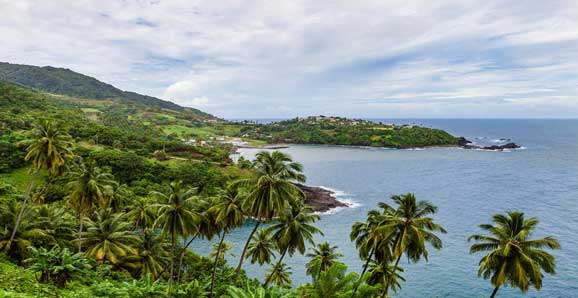Saint Vincent, Caribbean
By Yvonne Bausch
Fondly called “Vincy” by its residents, St Vincent is the largest and most populous of the 32 islands and cays that comprise the little-known nation of St Vincent & the Grenadines.
Where is St Vincent
St Vincent is the northernmost island of the Grenadines (part of the Lesser Antilles) with St Lucia to the north and Grenada to the south. With the recent opening of the Argyle International Airport, getting here has become a lot easier and continues to improve with new flights from North America being added every year. The island is well serviced with inter-island flights from Barbados, St Lucia, Puerto Rico, Martinique, and Trinidad with a few inter-island ferries between the Grenadines eight populated islands.
Many visitors arrive by private yacht and some decide to stay. St Vincent has long been a yachter’s mecca as skippers need only clear customs once and then have their pick of the multitude of quiet safe anchorages around the island and the Grenadine islands and cays to the South.
Activities and Things to Do on “St Vincent”
Although relatively unknown, St Vincent offers a lot for those who make their way to these shores. Yachting is a thriving industry here, with services ranging from supplying the thousands of visiting yachts, sailing courses, bareboat chartering, and gourmet crewed charters. The Blue Lagoon marina in the south of the island offers moorings, chandlery, and some of the best eateries in the island.
Favorite spots for the boating crowd are Wallilabou Bay and further south the postcard-perfect Tobago Cays. Both locations were used in filming the Pirates of the Caribbean and remain a firm favorite with residents and visitors alike.
Kayaking and windsurfing are popular pastimes with Shipping Bay on the east coast being the favorite spot for surfers.
For those attracted to life under the waves, St Vincent has healthy reefs and abundant marine life, multiple dive shops offer a range of dive sites for all experience levels. The shallow bays and coves provide easy and colorful snorkeling too.
St Vincent’s mountainous interior is a hiker’s paradise with trails for all abilities. The most rewarding (and perhaps least strenuous volcano hike in the Caribbean) is that to the top of the La Soufriere Volcano which is accessible from both the leeward and windward coasts. The most popular trail is from Rabacca. A paved track leads to the trailhead; which is a two-hour uphill climb to the lip of the crater. Here you can either go around the top of the crater and down to Richmond on the other side of the island, or down the steep trail to the active lava dome at the center of the crater (adds approximately two hours to your hike).
The Vermont Nature Trail in St Vincent’s 10,870-acre nature reserve is a two-mile trail through the verdant forest. Informative signs describe the flora and fauna as you make your way to the viewing platform for a glimpse of the rare St Vincent parrot.
A shorter yet more exhilarating hike—thanks to the rickety bamboo river crossing—is to Dark View Falls. Once over the bridge and through a pretty bamboo grove you will find the falls tumbling from a high cliff and into two pools perfect for swimming.
Kingstown, the capital of St Vincent, is a bustling town and the best place for shopping, although there are no fancy boutiques or designer stores as in the better-known Caribbean islands.
Kingstown makes up for that lack with a vibrant fruit and vegetable market, colorful characters, loud music, and colorful dollar vans which roar back and forth between the villages and town.
Kingstown is home to the oldest botanical garden in the Western hemisphere, created in 1756 it covers 20 acres and boasts a breadfruit tree descended from those bought over by Captain Bligh.
A popular weekend pastime is playing or watching cricket. It’s often a boisterous affair with ribald comments from the spectators. English is the official language here although the Vincentian creole in common use takes some getting used to.
[caribbean_signup]
Places to Eat
An authentic Vincy meal can be found at Vee Jays on Front Street in Kingstown, grab a seat and ask for a Roti. These are soft tortilla-like ‘skins’ stuffed with chicken, beef, fish, conch, or vegetable curry. They are hot, spicy and cost around $6 and one will keep you going for the rest of the day.
A more upmarket option is the French Veranda at the Marina Hotel on the Windward side of the island. Take a stroll along the boardwalk and drop in for a cocktail or enjoy a candlelit romantic dinner as the sun goes down.
For a truly authentic “Lime” (local slang for a good time or a party) head to the Bush Bar nestled in the bush above Vermont Valley. It’s a rustic open-air bar with cold beers, passion fruit and rum cocktails, and home cooked vitals (vegetarian dish of rice, vegetables, and lentils).
Cost of Living on St Vincent
Where you choose to live on the island and in what style will drastically affect how much you pay to rent or buy. A small local style wooden house inland would rent for $280 a month; double that for a more attractive area. If you want mod cons and an ocean view expect at least $1,500 a month.
Same applies to real estate. Land or small apartments can be purchased for $200,000 to $300,000. Villas start at $400,000 with some of the high-end villas listed at over one million.
Food and groceries are relatively inexpensive as St Vincent grows a lot of its own produce. However, anything imported (such as strawberries, wine, electronics, and cars) is going to cost at least twice what you would pay at home thanks to the hefty import duties levied against all imports.
*Feature Photo: ©iStock.com/argalis*

